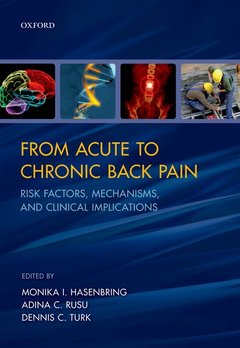Description
From Acute to Chronic Back Pain
Risk Factors, Mechanisms, and Clinical Implications
Coordinators: Hasenbring Monika I., Rusu Adina C., Turk Dennis C.
Language: English
Subjects for From Acute to Chronic Back Pain:
Publication date: 01-2012
616 p. · 17.7x24.9 cm · Hardback
616 p. · 17.7x24.9 cm · Hardback
Description
/li>Contents
/li>
Chronic back pain has been and continues to be a major cause of distress (both to people with persistent pain and their significant others), disability, work loss, and a huge cost to society. Moreover, with the aging population, it is becoming even more prevalent and as a consequence is having an escalating impact upon the healthcare systems and society as a whole worldwide. A significant issue concerns understanding why, although the majority of people with acute back symptoms recover in a reasonable time, a significant minority evolve into patients with chronic pain and prolonged pain-related disability. Understanding the variables that contribute to chronicity could serve as a basis for early intervention to prevent the downward spiral. In the past 15 years, psychological and psychobiological mechanisms have been identified as important risk factors in back pain, leading to the development of early screending methods (Yellow Flag diagnostics) and new psychosocial interventions. These work by closely targeting treatment modalities to patients' needs. However, many aspects of how acute pain becomes chronic pain remain unexplained. Recent neurobiological work investigating genetic, neurophysiological, and biomechanical processes has uncovererd important mechanisms involved in chronic and acute back pain. From Acute to Chronic Back Pain examines the risk factors and mechanisms involved in the transition from acute to chronic back pain. It integrates genetic, biomechnanical neurobiological, psychophysiological, psychosocial, and socieconomic risk factors. Moreover, the text examines advances in treatment approaches based on evidence from published studies-ranging from prevention of disability to pharmacological, psychological, and rehabilitative strategies and methods. Broad in scope, and with contributions from leading authorities in their respective fields, this book is a valuable and comprehensive work for the many specialities involved with back pain - including those in the fields of clinical and health psychology, physiology, epidemiology, and pain.
Preface. Section I: Current developments in epidemiology. 1. Epidemiology of back pain, from the laboratory to the bus stop: psychosocial risk factors, biological mechanisms and interventions in population-based research?. 2. Defining chronic pain by prognosis. Section II: Risk Factors of chronic back pain and disability: Biological Mechanisms. 3. Genetic factors modulating chronic back pain. 4. Peripheral and central sensitization as risk factors of low back pain. 5. Dysfunction of the hypothalamic-pituitary-adrenal axis and associated stress axes in the development of chronic LBP. 6. Central imaging of pain and the process of chronicity. 7. Structural brain changes in patients with chronic back pain. 8. The Psychophysiology of Chronic Back Pain Patients. Section III: Risk Factors of chronic back pain and disability: Biomechanical Mechanisms. 9. Electromyographically-determined Muscular Fatigue in Low Back Pain. 10. Unmasking the Deconditioning Paradigm for Chronic Low Back Pain Patients.. Section IV: Risk Factors of chronic back pain and disability: Sociodemographic and psychosocial mechanisms. 11. Screening of Psychological Risk Factors (Yellow Flags) for Chronic Back Pain and Disability. 12. Dispositional fear, anxiety sensitivity, and hypervigilence. 13. Processes Underlying the Relation between Catastrophizing and Chronic Pain: Implications for Intervention. 14. Fear-avoidance as a risk factor for the development of chronic back pain and disability. 15. Endurance?related pain responses in the development of chronic back pain. 16. Cognitive processing and self-pain enmeshment in chronic back pain. 17. Significant others in the chronicity of pain and disability. 18. Effects of Workers' Compensation Systems on Recovery from Disabling Injuries. 19. Work-related risk factors for transition to chronic back pain and disability. Section V: Practitioner's role in the process of care. 20. The Physician as Disability Advisor for Back Pain Patients. 21. The attitudes and beliefs of clinicians treating back pain: Do they affect patients' outcome?. Section VI: Clinical Implications - New approaches to Diagnostics and Treatment. 22. International guidelines for the diagnostics and treatment of acute, sub-acute and chronic back pain. Section VII: Clinical approaches for patients with acute and subacute LBP. 23. Engaging patients in their own care for back care: the role of education and advice in the prevention of chronic pain and disability. 24. Motivational Issues in Pain Management. 25. Pharmacotherapy of Low Back Pain. Section VIII: Subgroup-specific approaches for patients at risk for or with chronic pain. 26. Reviewing the concept of subgroups in sub-acute and chronic pain and the potential of customizing treatments. 27. Risk factor based cognitive behavioral therapy for acute and subacute back pain. Section IX: Clinical approaches for patients with established pain and disability. 28. Physical exercise interventions and low back pain. 29. Contextual cognitive behavioral therapy for chronic pain (including back pain). 30. Rehabilitation programs to prevent severely disabling chronic back pain.
© 2024 LAVOISIER S.A.S.



